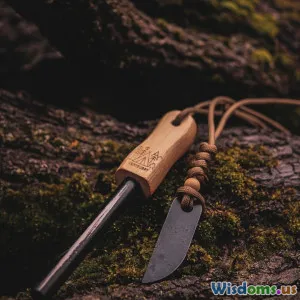
How to Build a Reliable Shelter with Minimal Tools in the Wild
7 min read Learn expert tips to build a sturdy, reliable shelter in the wild using minimal tools and natural resources. (0 Reviews)
How to Build a Reliable Shelter with Minimal Tools in the Wild
When you're thrown into the wilderness with just a few tools—or none at all—your ability to construct a reliable shelter becomes a critical survival skill. Shelter isn't just a rudimentary comfort; it's your barrier against the elements, your protection from wildlife, and your opportunity to preserve energy vital for long-term survival or rescue.
Why Shelter is Critical in Survival
Shelter serves as your first line of defense against exposure to heat, cold, rain, and wind. According to survival expert Les Stroud, "60% of survival concerns center around shelter, water, and fire." Neglecting shelter can lead to rapid loss of body heat or heat stroke, dramatically reducing your chance of survival.
Assess Your Environment
Before building, spend time observing your surroundings:
- Climate Conditions: Are you in a hot desert, a wet rainforest, or sub-zero forests? Each requires different shelter designs.
- Available Materials: Note the types and abundance of wood, leaves, snow, or rocks.
- Natural Shelter Options: Caves, rock overhangs, or dense tree cover can sometimes reduce workload.
Choosing the Right Location
The best shelter starts at the right location:
- Avoid hazard zones: Stay clear of flood zones, avalanche paths, animal trails, or unstable ground.
- Look for natural windbreaks: Hill bases, dense shrubbery, or large boulders help shield against harsh winds.
- Consider water proximity: While you want access to water, avoid building too close to it to reduce insect exposure and flooding risk.
Minimal Tools, Maximum Efficiency
Tools are often scarce. Here’s how to optimize what you have:
- Use a knife or multitool wisely: For cutting saplings, shaping wood, or carving stakes.
- Utilize natural tools: Sharp rocks, broken branches, and bones can serve cutting or digging functions.
- Employ cordage alternatives: Vines, bark strips, or roots can substitute for rope.
Types of Shelters You Can Build With Minimal Tools
1. Lean-to Shelter
Probably the simplest and quickest to build. Lean a sturdy ridgepole against a tree or rock at a 30-45 degree angle. Then, lay branches or sticks along the ridgepole to create a slanted roof.
- Insulation: Cover the frame with leaves, pine needles, or grass layers to trap heat.
- Example: Hunters and scouts use lean-tos because they require minimal setup and provide effective wind protection.
2. Debris Hut
More involved but excellent for warmth. Create a sturdy frame by leaning branches in a teepee style, then pile large amounts of debris — leaves, grass, pine needles — thickly over the frame.
- Survival Insight: Chris McNair-Brown, wilderness instructor, advocates debris huts as "the warmest emergency shelter when built with proper insulation thickness—at least a foot."
3. A-Frame Shelter
Construct an A-shaped frame by setting two poles against each other and securing a ridgepole at the top. Then stack smaller branches along both sides.
- Tip: Place the entrance facing away from prevailing winds to reduce drafts.
Step-by-Step Example: Constructing a Debris Hut
- Create a Ridgepole: Find a straight branch roughly 6-8 feet long.
- Set Up Frame: Prop the ridgepole between two forks or secure between two sturdy supports.
- Lay Supporting Bones: Lean smaller sticks against the ridgepole on both sides tightly.
- Insulate Heavily: Pile dry leaves, pine needles, mosses, and grass over the frame, at least 12 inches thick.
- Create Entrance: Leave a small gap or cover with layered debris for entry.
Important Considerations for Reliability
- Ventilation: A completely sealed shelter can cause suffocation; ensure air flow.
- Waterproofing: Position your shelter slightly elevated or on a slope to prevent water pooling inside.
- Structural Stability: Use stakes or secure branches with natural cordage for reinforcement.
Real-World Example: The 2010 Yukon Survival Incident
In 2010, a hiker lost in the Yukon territory survived six days by constructing a lean-to shelter from birch branches and insulating it with moss and pine needles. Despite freezing temperatures, his shelter helped retain enough body heat and shield him from brutal wind, which search and rescue credited as a key factor in his survival.
Final Tips to Enhance Your Shelter-
- Start small: Prioritize shelter over other needs once lost outdoors.
- Practice before you go: Learning shelter construction with minimal tools in a controlled environment can prevent mistakes.
- Use natural contours: For instance, depressions offer natural wind protection.
Conclusion
Building a reliable shelter in the wild with minimal tools is an achievable skill that could save your life. It requires keen observation of your environment, efficient use of available resources, and knowledge of basic structure types. While simple shelters like lean-tos and debris huts might seem elementary, their effectiveness stems from thoughtful construction and adaptation to environment.
With practice and attentiveness, you can master shelter building and boost your confidence and safety during any outdoor adventure or unexpected survival scenario. Remember, in the wild, a well-built shelter is more than wood and leaves—it’s your fortress against the unknown.
References:
- Stroud, Les. "Survive! Essential Skills and Tactics to Get You Out of Anywhere—and Alive." 2013.
- McNair-Brown, Chris. Survival techniques and shelter building, various field guides.
- Yukon Search and Rescue Reports, 2010 Incident Summary.
Rate the Post
User Reviews
Popular Posts



















